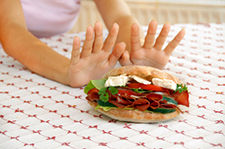
By Daniel Green
JOIN THE DISCUSSION!
What advice do you give your clients who might be dealing with feelings of guilt or embarrassment when they lose their motivation or have trouble sticking to their programs? Share your thoughts and experience in the comments section below.
Here’s the scene: It’s 8 o’clock at night and your client, Alex, is watching TV after a long day of work and family responsibilities, proud that he stuck to his eating and exercise plan for the day. Then it happens: His daughter walks in with a box of Girl Scout cookies she bought from a friend at school.
There are three possible outcomes in this situation. In the best-case scenario, the entire scene is averted because Alex’s wife and children are supportive of his weight-loss efforts and don’t want to do anything to jeopardize his success, so his daughter never offers him the cookies or even lets him know they’re in the house.
In the worst-case scenario, Alex eats a big handful of cookies, feels terribly guilty afterward, but then does the same thing a few nights in a row, eventually abandoning his weight-loss efforts altogether. Somewhere in the middle lies the most likely outcome. He eats a few cookies and feels guilty afterward, and heads to bed a few hours later disappointed with himself, but committed to getting back on track in the morning.

Putting Calories in Perspective
While both Zive and Rogers recommend intuitive, purposeful eating and a reduced focus on “dieting,” they acknowledge that using tools like calorie counting is often the best way for clients to understand what they have been putting in their mouths and what needs to change to achieve their goals.
We’ve all seen the disappointment on clients’ faces when they learn that 45 minutes of brisk walking on the treadmill burns “only” about 275 calories, but there is a flipside to that story. So many people beat themselves up with negative self-talk when they break their plan and overindulge: “I had a huge bowl of ice cream last night and ruined my diet.” Fitness professionals can teach clients an important lesson in this scenario: Consider a client who eats 500 calories of Ben and Jerry’s ice cream and declares that he “failed on my diet this week.” This is where a better understanding of calories—the fact that 500 calories equates to only one-seventh of a pound—is so valuable. The fitness professional should teach this client that he would have to make this bad decision every night of the week to gain a single pound, thereby reinforcing the notion that weight management is truly a matter of long-term lifestyle change that a single moment of weakness should not derail. It is about making the wise choice as consistently as possible and not allowing momentary lapses to turn into permanent relapses.
Regardless of whether your clients are counting calories, carbs or points, many have undoubtedly faced this moment of truth countless times. This scenario raises a few important questions. First, what is it about the five or 10 minutes of pleasure a snack can bring that overpowers all the good intentions in the world? If Alex knows—truly knows—that he will regret the decision a few minutes later, why can’t he stop himself from indulging? Why does one moment of weakness (if that is the outcome) often spiral into a complete relapse to unhealthy behaviors? And finally, what can you as a fitness professional do to help clients overcome these obstacles and stay the course over the long haul?
Think Long-term While Living in the Moment
One technique that you can teach your clients is to pause for a few minutes and consider how they will feel after indulging. If Alex can anticipate guilt or disappointment on the not-too-distant horizon, then he should try to turn the ability to see those impending negative emotions into positive self-talk. “I’ve done a great job today, and I don’t want to sabotage my efforts for a few moments of enjoyment.”
It is important to realize that no one—including fitness professionals—sticks to their plan 100 percent of the time. “There should be room for an occasional cupcake in your plan if you are going to be successful in the long-term,” notes Tracie Rogers, Ph.D., director of the Human Movement Program at A.T. Still University. Dr. Rogers urges fitness professionals to talk to clients about lifestyle behavior, not calorie counting. “Avoid being too ‘diet’-focused in your conversations with clients. Instead, teach them to modify their behaviors to achieve hoped-for outcomes.” In other words, successful long-term weight management is not about these individual moments where clients either “fail” or “succeed,” but about having a long-term plan for truly changing their lifestyle.
In addition, it is important to teach clients to avoid thinking of these moments of “failure” of being indicative of anything beyond that moment. Many dieters tend to treat every slip-up like a catastrophe, saying “I blew my diet” or “I’ve already ruined my day, so there’s no harm in eating a bit more.” Instead, urge clients to think of the next meal, or even the next (possible) bite, as the next opportunity to get right back on track.
At the same time, if a client is out to dinner with friends or at a work celebration, you don’t want her to be wracked with guilt and fighting herself through the entire event. Michelle Murphy Zive, M.S., R.D., executive director of the UC San Diego Initiatives for Communities Putting Prevention to Work and the Network for a Healthy California, reminds us that food should not become the enemy. “Food is not only about fueling the body, but also about socializing with loved ones—and food is meant to be enjoyed.” If a client makes the decision to have a slice of cheesecake after dinner or a favorite pasta dish at a local restaurant, Zive says the key is to savor and truly enjoy the indulgence, but then to get right back on track with the next meal. Remind clients that there is a big difference between sharing a favorite dessert on a special night out, going for an after-dinner walk and waking up with a plan to continue your efforts, versus sneaking a handful of Girl Scout cookies while watching late-night TV and going to bed plagued with guilt and reconsidering your weight-loss goals.

Michelle Murphy Zive offers the following tips to share with your clients for handling moments when an opportunity for a high-calorie snack presents itself unexpectedly, whether it is a slice of birthday cake at the office or a child’s unfinished French fries:
- Walk away from the food.
- Get busy by taking a short walk or keeping your hands busy.
- Brush your teeth.
- Chew gum.
- Take five deep breaths.
- Write in a journal about what you are feeling.
- Check in: Ask yourself, am I really hungry or just [fill in the blank]?
- Eat a bite of the snack.
Control What Can Be Controlled
Part of your job as a fitness professional is to educate your clients about food so they can develop a plan that works for their individual circumstances. “Talk to clients about making healthy choices wherever they are,” says Rogers, “whether at home, the office, or a special event.” Zive concurs, pointing out that it’s important to focus on controlling what you can control. She also suggests being mindful to avoid thinking about “good” foods and “bad” foods, and instead think about not eating “too much food.” Another aspect of exerting control over your environment involves bringing a healthy dish with you when attend an event. As Zive says, “You can’t complain about there being no healthy options at the Super Bowl party if you didn’t bring any yourself.”
Speaking of control, one essential step that those watching their weight can take is to ensure their environment is supportive of their efforts. Zive recommends having tasty, guilt-free snacks ready to eat, whether that means cutting up fruits and veggies or dividing family bags of popcorn into portion-sized containers. Remember, clients are inundated with delicious, unhealthy food options all day long, so it takes a bit of work and forethought to counteract the constant temptations.
Finally, and perhaps most importantly, help your clients build better relationships with their bodies, so they are respectful and appreciative of what they can do. The human body needs proper nutrition and hydration for fuel and efficient functioning. If your clients are ever going to be able to make a decision to spoil themselves and enjoy a decadent meal with friends while remaining truly guilt-free, they first need to have a long-term plan that allows them to do so without losing focus on their overall goals. By planning ahead and focusing on the big picture, your clients can free themselves from the cycle of guilt that dieting often produces.
_________________________________________________________________________
 Daniel J. Green is an editorial consultant and freelance writer based in Asheville, N.C. In addition to his consulting work with organizations including the American Council on Exercise, International Association of Fire Fighters and Agriculture Future of America, Daniel has written feature articles for local publications in Western North Carolina (WNC), including WNC Parent and WNC Magazine.
Daniel J. Green is an editorial consultant and freelance writer based in Asheville, N.C. In addition to his consulting work with organizations including the American Council on Exercise, International Association of Fire Fighters and Agriculture Future of America, Daniel has written feature articles for local publications in Western North Carolina (WNC), including WNC Parent and WNC Magazine.